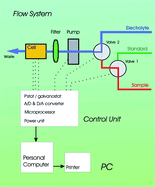Determination of nickel in hair samples by graphite furnace atomic absorption spectrometry and flow-through stripping chronopotentiometry
Abstract

* Corresponding authors
a State Institute of Public Health, Cesta k nemocnici 1, Banská Bystrica, Slovak Republic
b
Slovak University of Technology, Institute of Analytical Chemistry, Radlinského 9, Bratislava, Slovak Republic
E-mail:
ernest.beinrohr@stuba.sk
c University of SS. Cyril and Methodius in Trnava, Faculty of Natural Sciences, Námestie Jozefa Herdu 2, Trnava, Slovak Republic

 Please wait while we load your content...
Something went wrong. Try again?
Please wait while we load your content...
Something went wrong. Try again?
D. Borosova, A. Manova, J. Mocak and E. Beinrohr, Anal. Methods, 2010, 2, 1913 DOI: 10.1039/C0AY00007H
To request permission to reproduce material from this article, please go to the Copyright Clearance Center request page.
If you are an author contributing to an RSC publication, you do not need to request permission provided correct acknowledgement is given.
If you are the author of this article, you do not need to request permission to reproduce figures and diagrams provided correct acknowledgement is given. If you want to reproduce the whole article in a third-party publication (excluding your thesis/dissertation for which permission is not required) please go to the Copyright Clearance Center request page.
Read more about how to correctly acknowledge RSC content.
 Fetching data from CrossRef.
Fetching data from CrossRef.
This may take some time to load.
Loading related content
